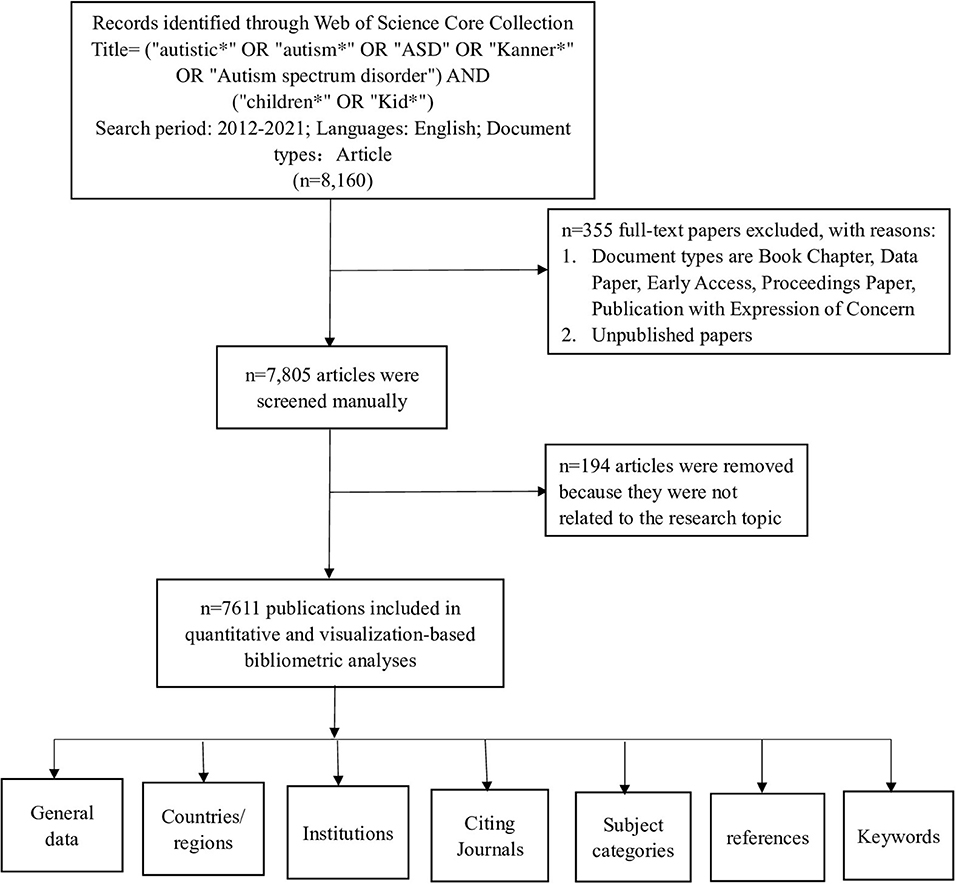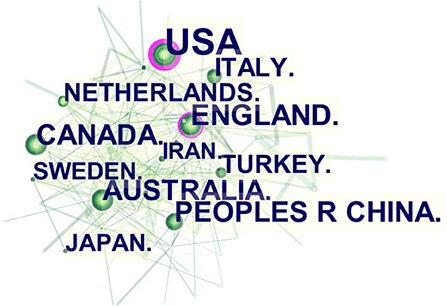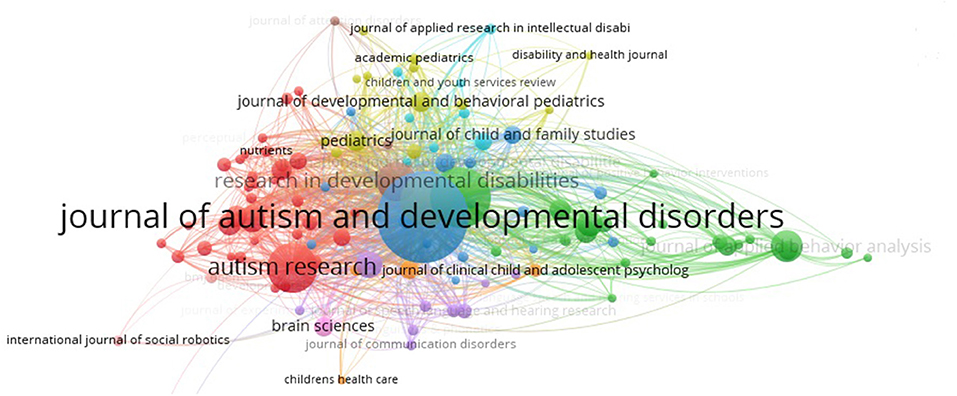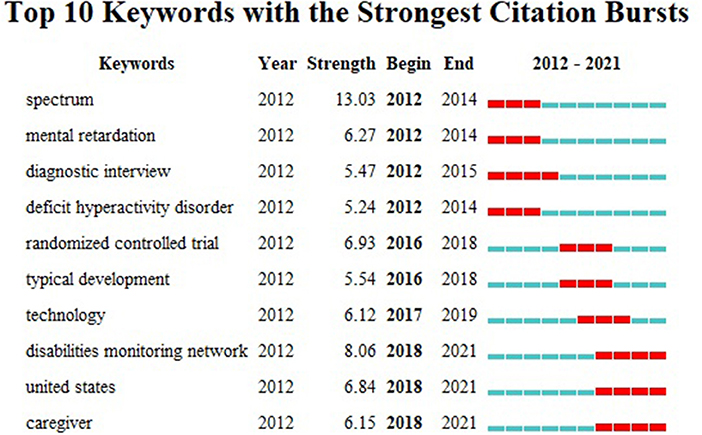
94% of researchers rate our articles as excellent or good
Learn more about the work of our research integrity team to safeguard the quality of each article we publish.
Find out more
ORIGINAL RESEARCH article
Front. Public Health, 31 August 2022
Sec. Children and Health
Volume 10 - 2022 | https://doi.org/10.3389/fpubh.2022.925475
This article is part of the Research TopicPrecision Medicine of Non-Communicable Diseases in ChildrenView all 10 articles
Parts of this article's content have been modified or rectified in:
Erratum: Bibliometric analysis of research themes and trends in childhood autism spectrum disorders from 2012 to 2021
Background: Autism spectrum disorders (ASD) are heterogeneous neurodevelopmental conditions that affect people worldwide. Early diagnosis and clinical support help achieve good outcomes. However, medical system structure and restricted resource availability create challenges that increase the risk of poor outcomes. Understanding the research progress of childhood ASD in recent years, based on clinical literature reports, can give relevant researchers and rehabilitation therapists more resonable research guides.
Objective: This bibliometric study aimed to summarize themes and trends in research on childhood ASD and to suggest directions for future enquiry.
Methods: Citations were downloaded from the Web of Science Core Collection database on childhood ASD published from 1 January 2012, to 31 December 2021. The retrieved information was analyzed using CiteSpace.5.8. R3, and VOS viewer.
Results: A total of 7,611 papers were published across 103 areas. The United States was the leading source of publications. The clusters that have continued into 2020 include coronavirus disease 2019, gut microbiota, and physical activity, which represent key research topics. Keywords with frequency spikes during 2018–2021 were “disabilities monitoring network,” “United States,” and “caregiver.”
Conclusions: The Autism and Developmental Disabilities Monitoring Network in the United States can be used as a reference for relevant workers worldwide. An intelligent medical assistant system is being developed. Further studies are required to elucidate challenges associated with caring for a child with ASD.
Autism spectrum disorders (ASD) are heterogeneous neurodevelopmental conditions, characterized by early-onset difficulties in communication and restricted, repetitive behavior and interests (1). In 2020, the World Health Organization reported that 1 in 160 children worldwide presents with ASD (2). The United States National Center for Health Statistics reported in 2016 that the prevalence of ASD among children aged 3 to 17 years is 1 in 45 and that it is increasing, which is a cause for concern. ASD is a lifelong neurodevelopmental disorder with a profound impact on intellectual and general abilities and psychological functioning (3, 4). ASD was first described based on the characteristics of 11 children observed by child psychiatrist Kanner in 1943 (5). The definition of ASD continues to evolve (1, 6–8). The understanding of ASD is also evolving, and the number of related studies is increasing. Examining what currently constitutes research frontiers may help set directions for future research (9). This study aimed to examine the current evidence on childhood ASD, including research trends and leading topics, published over the past decade, and to propose directions for future research. These findings may be used as a reference for epidemiologists, pediatricians, rehabilitation therapists, and caregivers.
This study aimed to cover the following aspects. We analyzed Science Citation Index for childhood ASD studies using bibliometric methods. Countries, regions, institutions, and periodicals of study origin, study categories, keywords, and references per study were included in the dataset. Visual representation of findings was provided. Research influence of countries, regions, institutions, and journals was examined, and leading research topics were reported. We went over the hot spot trend in greater depth.
On 24 March 2022, all citations published between 1 January 2012, and 31 December 2021, were retrieved from the Web of Science Core Collection (WoSCC). The search strategy was set as TI = (“autistic*” OR “autism*” OR “ASD” OR “Kanner*” OR “Autism spectrum disorder”) AND TI = (children OR Kid*), the document type was “ARTICLE,” and the timeframe was from 1 January 2012 to 31 December 2021. A total of 8,160 papers were retrieved. After manual screening, 7,611 articles were included, and data on the following variables were extracted: title, publication year, country or region, institution, journal, references, and keywords (Figure 1).

Figure 1. Study flow diagram shows eligibility criteria and bibliometric analysis protocol for childhood Autism Spectrum Disorders (ASD).
Citation features were analyzed using CiteSpace.5.8. R3 and VOSviewer. The H-index was used to estimate the importance or impact of citations obtained from WoSCC.
Both the retrieval result analyzer of Web of Science database and the duplicate removal function of CiteSpace software can obtain the number of documents issued each year. Over the past 10 years, the number of studies on childhood ASD has increased (Figure 2). The number of publications in this area increased from 2011 to 2018. More than 1,000 research papers were published in this area from 2018 to 2020. Finally, from 2020 to 2021, the number of documents decreased slightly.
Using the country cooperation analysis function of CiteSpace, we can get the number of countries that have published articles and the influence of articles from a country. A total of 7,611 papers were published in 103 countries or regions. Collaborations among countries/regions are shown in Figure 3. The number of publications corresponds to the size of tags or nodes. Centrality can be ascertained from the purple ring area. Regions with the greatest number of citations included the United States (n = 3,655), Britain (n = 653), Australia (n = 553), China (n = 478), and Canada (n = 472). Among them, the United States (0.40) and Britain (0.17) have purple rings, representing articles from these regions have been cited more frequently than articles from other countries (Table 1). The H-index represents citation influence. The three countries with the highest h-index are the United States (102), England (58) and Canada (50).

Figure 3. Collaborations of countries or regions reporting studies on childhood ASD from 2012 to 2021.
The cooperation between institutions and the number of published articles of each institution can be achieved through CiteSpace software. Table 2 lists the top ten institutions with the largest number of documents, and their partnerships are shown in Figure 4. Eight of them are located in the United States, one in Canada, and one in the United Kingdom. The total link strength shows the influence of each institution.
Using VOSviewer to analyze the citation source journals and co cited journals. The documents in the highest citing journals represent leading research topics. The research field of highly cited journals are research basic knowledge. Tables 3, 4 show the top ten citing journals and cited journals, respectively. The leading research fields included psychology, special education, psychiatry, rehabilitation medicine, behavioral science, rehabilitation medicine, genetics, and neuroscience. Areas cited at increased frequencies included psychology, psychiatry, special education, rehabilitation medicine pediatrics, and behavioral science. The Journal of Autism and Developmental Disorders emerged as the most influential journal in this field (Figure 5).

Figure 5. The cooperation of citiation journals that contributed to publications on Childhood ASD from 2012 to 2021.
The default setting of CiteSpace is changed to the following mode: “Year Per Slice” = 2, “Top N%” = 30.0%, and “Minimum Duration” = 2. Figure 6 summarizes the leading keywords, including the year of emergence. The red square in Figure 6 represents emerging keywords for the investigated timeline. The most frequently used keywords were “spectrum” (2012–2014), “deficit hyperactivity disorder” (2012–2014), “diagnostic interview” (2012–2015), “randomized controlled trial” (2016–2018), “typical development” (2016–2018), “technology” (2017–2019), “disabilities monitoring network” (2018–2021), “United States” (2018–2021), and “caregiver” (2018–2021).

Figure 6. Keywords with the strongest citation bursts of publications on childhood ASD from 2012 to 2021.
Using the default setting of CiteSpace to cluster the co cited documents and choose label clusters with indexing terms. The clustering labels of co-cited articles depend on citing and cited journals. The cited studies constitute knowledge base of research. The frequency of reference use represents its influence. Co-citations reveal research themes and development background. Table 5 lists the top 10 cited studies, which include research of diagnostic criteria, intervention methods, epidemiological findings, and ASD characteristics. Two of these studies examined ASD within families. The clustering labels of cited documents are obtained from the citing documents. Figure 7 presents clusters that continued into 2020, including #2 COVID-19, #4 gut microbiota, and #5 physical activity.
The number of studies on childhood ASD has increased likely due to a combination of educational and medical system changes, which increased disease awareness. The number of published studies decreased from 2020 to 2021 likely due to restrictions associated with the coronavirus disease 2019 pandemic. The United States is the leading source of studies, suggesting policies and regulations in this country are more responsive to the needs of autism patients than those in other countries. The most influential journal in this field is the Journal of Autism and Developmental Disorders. This field includes disciplines such as psychology, psychiatry, special education, rehabilitation, medicine, pediatrics, and behavioral science. Meanwhile, keyword co-occurrence and reference cluster analysis revealed changes in research focus over time. From the emerging keywords from 2012 to 2015, the diagnosis of ASD and its comorbidity were the research hotspots of that year. In 2016 and 2017, we tend to establish randomized controlled trials within ASD groups and the differences between ASD and typical development groups. Based on previous research findings, researchers began looking for more appropriate technologies to establish disability monitoring networks and strengthen attention to ASD caregivers from 2017 to 2021.
Centers for Disease Control and Prevention (CDC) began monitoring the prevalence of ASD in 1996. The Children's Health Act of 2000 authorized CDC to establish the Autism and Developmental Disabilities Monitoring (ADDM) Network, which aims to assess ASD prevalence and diagnosis timing in children aged 4 and 8 years (19). The ADDM Network has established ASD and developmental disorder monitoring sites across the United States, starting with six sites in 2000 to 14 sites in 2002, and then to 8 sites in 2004 (20). Eleven and 14 sites were tested in 2006 and 2008, respectively (21, 22). From 2010 to 2018, ASD monitoring for children aged 8 years was available at 11 states (11, 23–26). The ADDM Network reports provide data on region-, sex-, and age-based differences in ASD prevalence and diagnostic challenges involved, including best practice guidance. In addition, the ADDM Network updates biennially ASD prevalence data in children aged 4 years, providing foundational public health evidence. In a study published in 2017, Soke et al. investigated early detection rate of ASD in infants born between 2002 and 2006 and examined at five ADDM Network sites, showing differences in detection standards among regions (27). Yingling et al. reported in 2019 that more than half of the United States' counties lack a Board Certified Behavior Analyst (BCBA) qualified to provide behavioral and psychological assessments and interventions due to differences in reimbursement ratios (28). This finding suggests that many children with ASD do not receive the required support.
The research on the prevalence monitoring of autism is still worthy of attention. Disability monitoring networks are an essential source of research data and clinical guidance, informing research and treatment strategies, and helping improve patient outcomes. This relies on scientific diagnostic tools.
Research into caregivers of children with ASD covers aspects such as caregiver demographic characteristics and views on treatment, nursing training, and health problem, quality of life, and family cohesion surveys, as well as input into specialist nursing and intelligent care system development.
Demographic characteristics of patients, caregivers, and communities affect the perception of patients with ASD. The mothers of 396 children from Singapore completed a quantitative checklist for autism in adults, revealing that child sex, cognitive function, birth order, mother age, and ethnicity were not characteristics of autism reported by caregivers. Delayed or impaired language development in the child and depressive symptoms and low education level in the mother were associated with social autism (29). Caregivers able to predict child problematic behavior may take action to minimize this risk. However, such predictions are challenging for caregivers that do not receive BCBA support, in which case the use of artificial intelligence technologies may be useful. Zheng et al. proposed a machine learning-based framework that helps predict problem behavior (30). Following an early diagnosis, caregivers of children with ASD need specialist education to help meet child needs. This approach also encourages social interaction among caregivers (31), which helps improve caregiver physical and psychological health and quality of life (32, 33). In 2021, Nie et al. proposed an immersive interaction system based on augmented reality to help autistic children practice social attention skills (34).
There are some limitations to this study. First, we downloaded only citations from the WoSCC database. The findings may differ if citations from other databases are included. Second, despite efforts to reduce bias in this study, no study method can reduce bias present in the original studies. Third, this study only included research findings published between 2012 and 2021. Some relevant studies are on-going, precluding inclusion in the present study, which may subject these results to the effects of time lag. Some of the most recent research hotspots require manual reading to be discovered. The use of artificial intelligence in medicine is increasing, providing novel opportunities to codify existing bias and change practice (35); the use of these technologies in ASD research and care is particularly promising (36).
Disability monitoring networks and caregiver-focused questions are the leading areas of research in childhood ASD, aiming to improve diagnosis, interventions, and outcomes. Many questions in this field remain unanswered. Eleven sites across the United States provide ASD prevalence data, which may support policy development and clinical practice. These data may help establish rehabilitation intervention systems for caregivers, supporting disease management. The use of artificial intelligence-based technologies may support research and clinical practice, including studies aimed at elucidating neurobiomarkers of ASD. Remote assessment and intervention guidance is required in the time of pandemics (37, 38).
The original contributions presented in the study are included in the article/supplementary files, further inquiries can be directed to the corresponding author.
JZ, YL, and FZ acquired, analyzed the data, and drafted the manuscript. FF, XD, and XingW analyzed the data. MW and XiaoW designed the research, acquired the article information, and revised the manuscript. All authors agreed to be accountable for the content of the work. All authors contributed to the article and approved the submitted version.
The work was financially supported the Key R&D and Promotion Projects in Henan Province (222102310615) and Henan Province Medical Science and Technology Key Project Jointly Constructed by Province and Ministry (SBGJ202102189).
The authors declare that the research was conducted in the absence of any commercial or financial relationships that could be construed as a potential conflict of interest.
All claims expressed in this article are solely those of the authors and do not necessarily represent those of their affiliated organizations, or those of the publisher, the editors and the reviewers. Any product that may be evaluated in this article, or claim that may be made by its manufacturer, is not guaranteed or endorsed by the publisher.
1. Katz L, Nayar K, Garagozzo A, Schieszler-Ockrassa C, Paxton J. Changes in autism nosology: the social impact of the removal of asperger's disorder from the diagnostic and statistical manual for mental disorders, fifth edition (DSM-5). J. Autism Dev. Disord. (2020) 50:3358–66. doi: 10.1007/s10803-019-04233-4
3. Cai RY, Richdale AL, Dissanayake C, Uljarevic M. Resting heart rate variability, emotion regulation, psychological wellbeing and autism symptomatology in adults with and without autism. Int J Psychophysiol. (2019) 137:54–62. doi: 10.1016/j.ijpsycho.2018.12.010
4. Leader G, O'Reilly M, Gilroy SP, Chen JL, Ferrari C, Mannion A, et al. Comorbid feeding and gastrointestinal symptoms, challenging behavior, sensory issues, adaptive functioning and quality of life in children and adolescents with autism spectrum disorder. Dev Neurorehabil. (2021) 24:35–44. doi: 10.1080/17518423.2020.1770354
6. Rutter M. Diagnosis and definition of childhood autism. J Autism Childhood Schizophrenia. (1978) 8:139–61. doi: 10.1007/BF01537863
7. Pichot P. [DSM-III: the 3d edition of the Diagnostic and Statistical Manual of Mental Disorders from the American Psychiatric Association]. Rev Neurol. (1986) 142:489–99.
8. Bell CC. DSM-IV: diagnostic and statistical manual of mental disorders. JAMA. (1994) 272:828–9. doi: 10.1001/jama.1994.03520100096046
9. Lai MC, Lombardo MV, Baron-Cohen S. Autism. Lancet. (2014) 383:896–910. doi: 10.1016/S0140-6736(13)61539-1
10. American Psychiatric Association. DC. DSM-5 Task Force Diagnostic and Statistical Manual of Mental Disorders: DSM-5. Washington, DC: American Psychiatric Association (2013).
11. Baio J, Wiggins L, Christensen DL, Maenner MJ, Daniels J, Warren Z, et al. Prevalence of autism spectrum disorder among children aged 8 years - autism and developmental disabilities monitoring network, 11 sites, United States, 2014. MMWR Surveill Summ. (2018) 67:1–23. doi: 10.15585/mmwr.ss6706a1
12. Hayes SA, Watson SL. The impact of parenting stress: a meta-analysis of studies comparing the experience of parenting stress in parents of children with and without autism spectrum disorder. J Autism Dev Disord. (2013) 43:629–42. doi: 10.1007/s10803-012-1604-y
13. Dawson G, Rogers S, Munson J, Smith M, Winter J, Greenson J, et al. Randomized, controlled trial of an intervention for toddlers with autism: the early start denver model. Pediatrics. (2010) 125:e17–23. doi: 10.1542/peds.2009-0958
14. Elsabbagh M, Divan G, Koh YJ, Kim YS, Kauchali S, Marcin C, et al. Global prevalence of autism and other pervasive developmental disorders. Autism Res. (2012) 5:160–79. doi: 10.1002/aur.239
15. Wong C, Odom SL, Hume KA, Cox AW, Fettig A, Kucharczyk S, et al. Evidence-based practices for children, youth, and young adults with autism spectrum disorder: a comprehensive review. J Autism Dev Disord. (2015) 45:1951–66. doi: 10.1007/s10803-014-2351-z
16. Schreibman L, Dawson G, Stahmer AC, Landa R, Rogers SJ, McGee GG, et al. Naturalistic developmental behavioral interventions: empirically validated treatments for autism spectrum disorder. J Autism Dev Disord. (2015) 45:2411–28. doi: 10.1007/s10803-015-2407-8
17. Loomes R, Hull L, Mandy WPL. What is the male-to-female ratio in autism spectrum disorder? A systematic review and meta-analysis. J Am Acad Child Adolesc Psychiatry. (2017) 56:466–74. doi: 10.1016/j.jaac.2017.03.013
18. Christensen DL, Bilder DA, Zahorodny W, Pettygrove S, Durkin MS, Fitzgerald RT, et al. Prevalence and characteristics of autism spectrum disorder among 4-year-old children in the autism and developmental disabilities monitoring network. J Dev Behav Pediatrics. (2016) 37:1–8. doi: 10.1097/DBP.0000000000000235
19. Control Centers for Disease, Prevention. (2007). Prevalence of autism spectrum disorders–autism and developmental disabilities monitoring network, six sites, United States, 2000. MMWR Surveill Summ. (2007) 56:1–11. Available online at: https://www.cdc.gov/mmwr/preview/mmwrhtml/ss5601a1.htm
20. Centers for Disease Control and Prevention. Prevalence of autism spectrum disorders–autism and developmental disabilities monitoring network, 14 sites, United States. MMWR Surveill Summ. (2007) 56:12–28. Available online at: https://www.cdc.gov/mmwr/preview/mmwrhtml/ss5601a2.htm
21. Control Centers for Disease and Prevention. Prevalence of autism spectrum disorders-autism and developmental disabilities monitoring network, United States. MMWR Surveill Summ. (2009) 58:1–20. Available online at: https://www.cdc.gov/mmwr/preview/mmwrhtml/ss5810a1.htm
22. Autism, Developmental Disabilities Monitoring Network Surveillance Year Principal, Investigators. Prevalence of autism spectrum disorders—autism and developmental disabilities monitoring network, 14 sites, United States. MMWR Surveill Summ. (2012) 61:1–19. Available online at: https://www.cdc.gov/mmwr/preview/mmwrhtml/ss6103a1.htm
23. Baio J. Prevalence of autism spectrum disorder among children aged 8 years-autism and developmental disabilities monitoring network, 11 sites, United States 2010. MMWR Surveill Summ. (2014) 63:1–21. Available online at: https://www.cdc.gov/mmwr/preview/mmwrhtml/ss6302a1.htm
24. Christensen DL, Baio J, Braun KV, Bilder D, Charles J, Constantino JN, et al. Prevalence and characteristics of autism spectrum disorder among children aged 8 years - autism and developmental disabilities monitoring network, 11 sites, united states, 2012. MMWR Surveill Summ. (2016) 65:1–23. doi: 10.15585/mmwr.ss6503a1
25. Maenner MJ, Shaw KA, Bak J, Washington A, Patrick M, DiRienzo M, et al. Prevalence of autism spectrum disorder among children aged 8 years - autism and developmental disabilities monitoring network, 11 sites, United States, 2016. MMWR Surveill Summ. (2020) 69:1. doi: 10.15585/mmwr.ss6904a1
26. Maenner MJ, Shaw KA, Bakian AV, Bilder DA, Durkin MS, Esler A, et al. Prevalence and characteristics of autism spectrum disorder among children aged 8 years - autism and developmental disabilities monitoring network, 11 sites, United States, 2018. MMWR Surveill Summ. (2021) 70:16. doi: 10.15585/mmwr.ss7011a1
27. Soke GN, Maenner MJ, Christensen D, Kurzius-Spencer M, Schieve LA. Brief report: estimated prevalence of a community diagnosis of autism spectrum disorder by age 4 years in children from selected areas in the United States in 2010: evaluation of birth cohort effects. J Autism Dev Disord. (2017) 47:1917–22. doi: 10.1007/s10803-017-3094-4
28. Yingling ME, Ruther MH, Dubuque EM, David SM. County-level variation in geographic access to board certified behavior analysts among children with autism spectrum disorder in the United States. Autism. (2021) 25:1734–45. doi: 10.1177/13623613211002051
29. Goh DA, Gan D, Kung J, Baron-Cohen S, Allison C, Chen H, et al. Child, maternal and demographic factors influencing caregiver-reported autistic trait symptomatology in toddlers. J Autism Dev Disord. (2018) 48:1325–37. doi: 10.1007/s10803-018-3471-7
30. Zheng ZBK, Staubitz JE, Weitlauf AS, Staubitz J, Pollack M, Shibley L, et al. A Predictive Multimodal Framework to Alert Caregivers of Problem Behaviors for Children with ASD (PreMAC). Sensors. (2021) 21:19. doi: 10.3390/s21020370
31. Recio P, Molero F, Garcia-Ael C, Perez-Garin D. Perceived discrimination and self-esteem among family caregivers of children with autism spectrum disorders (ASD) and children with intellectual disabilities (ID) in Spain: the mediational role of affiliate stigma and social support. Res Dev Disabil. (2020) 105:8. doi: 10.1016/j.ridd.2020.103737
32. Chen JY, Strodl E, Huang LH, Chen YJ, Yang GY, Chen WQ, et al. Early electronic screen exposure and autistic-like behaviors among preschoolers: the mediating role of caregiver-child interaction, sleep duration and outdoor activities. Children. (2020) 7:15. doi: 10.3390/children7110200
33. DesChamps TD, Ibanez LV, Edmunds SR, Dick CC, Stone WL. Parenting stress in caregivers of young children with ASD concerns prior to a formal diagnosis. Autism Res. (2020) 13:82–92. doi: 10.1002/aur.2213
34. Nie GT, Ullal A, Zheng Z, Swanson AR, Weitlauf AS, Warren ZE, et al. An immersive computer-mediated caregiver-child interaction system for young children with autism spectrum disorder. IEEE Trans Neural Syst Rehabil Eng. (2021) 29:884–93. doi: 10.1109/TNSRE.2021.3077480
35. Straw I. The automation of bias in medical Artificial Intelligence (AI): decoding the past to create a better future. Artif Intell Med. (2020) 110:3. doi: 10.1016/j.artmed.2020.101965
36. Mahmood A, Nayak P, English C, Deshmukh A, Manikandan NSU, Solomon JM. Adherence to home exercises and rehabilitation (ADHERE) after stroke in low-to-middle-income countries: a randomized controlled trial. Top Stroke Rehabil. (2021) 29:1–11. doi: 10.1080/10749357.2021.1940800
37. Newbutt N, Schmidt MM, Riva G, Schmidt C. The possibility and importance of immersive technologies during COVID-19 for autistic people. J Enabl Technol. (2020) 14:187–99. doi: 10.1108/JET-07-2020-0028
Keywords: autism spectrum disorders, children, bibliometrics, CiteSpace, VOSviewer
Citation: Zhao J, Lu Y, Wu X, Zhou F, Fei F, Wu X, Ding X and Wang M (2022) Bibliometric analysis of research themes and trends in childhood autism spectrum disorders from 2012 to 2021. Front. Public Health 10:925475. doi: 10.3389/fpubh.2022.925475
Received: 23 June 2022; Accepted: 29 July 2022;
Published: 31 August 2022.
Edited by:
Corrado Romano, University of Catania, ItalyReviewed by:
Yazhe Wang, Third Affiliated Hospital of Zhengzhou University, ChinaCopyright © 2022 Zhao, Lu, Wu, Zhou, Fei, Wu, Ding and Wang. This is an open-access article distributed under the terms of the Creative Commons Attribution License (CC BY). The use, distribution or reproduction in other forums is permitted, provided the original author(s) and the copyright owner(s) are credited and that the original publication in this journal is cited, in accordance with accepted academic practice. No use, distribution or reproduction is permitted which does not comply with these terms.
*Correspondence: Minli Wang, d2FuZ21pbmxpMTk4MUAxNjMuY29t
†These authors have contributed equally to this work and share first authorship
Disclaimer: All claims expressed in this article are solely those of the authors and do not necessarily represent those of their affiliated organizations, or those of the publisher, the editors and the reviewers. Any product that may be evaluated in this article or claim that may be made by its manufacturer is not guaranteed or endorsed by the publisher.
Research integrity at Frontiers

Learn more about the work of our research integrity team to safeguard the quality of each article we publish.